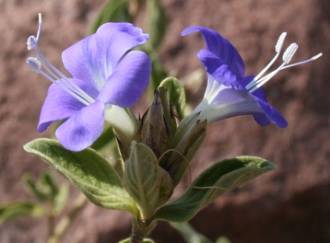Barleria rogersii
Barleria rogersii S.Moore
Family: Acanthaceae
Common names: Rogers' bushviolet
Introduction
To cover the bare sunny spots between rocks in your garden you need Barleria rogersii.

Description
Description
Barleria rogersii is an unarmed (without thorns) perennial herb or subshrub up to 0.8 m high. The leaves are simple, opposite, elliptic, and both sides of the leaves and the stems are covered with star-like hairs. The petioles (leaf stalks) are short. The flowers are arranged in a loose terminal spike. The corolla (petals of the flower) is 2-lipped. The upper lip is 2-lobed and the lower lip 3-lobed. The lips are more or less the same size. The corolla is bluish-mauve and the corolla tube white.

A fruit capsule bears the seeds. The base of each flower is covered by two small leaf-like structures called bracts. Ripe fruit capsules explode to distribute the seeds in different directions.
Distribution and habitat
Distribution description
Barleria rogersii grows in well-drained sandy soils, in full sun and has been collected in the Limpopo Province, Namibia, Angola and Mozambique.
Derivation of name and historical aspects
History
Named after Rev. F.A. Rogers (1876-1944), railway missionary and later Archdeacon of Polokwane. He was a prolific plant collector and went on several collecting trips with, among others, Professor C.E. Moss.
Ecology
Ecology
Barleria rogersii is pollinated by insects and attracts various species of butterflies.
Uses
Use
Barleria species are exceptionally suitable to stabilize eroding soil, landscaping waterwise gardens, rockeries and sunny areas in the garden.

Growing Barleria rogersii
Grow
Barleria rogersii can be propagated by seed or cuttings.
To prevent seed being lost it can be collected as the capsules turn brown and before they explode.The seeds should be planted in a mixture of two parts good soil and one part clean river sand. Place the container in a shady spot in your garden and water once a week.
Germination of the seeds takes place within a week. Transplanting the seedlings into bags should be done when the seedlings are more or less 100 mm high.
Cuttings should be made in summer, making use of softwood plant material. Take cuttings 70-120 mm long, treat with a hormone powder and plant in a mixture of even parts good soil and river sand. Put the cuttings in a shady place and water twice a week. Transplant the rooted cuttings after about three months into a good soil mixture.
References
- Little, John. R. & Jones, C. Eugene 1980. A dictionary of Botany. Van Nostrand Reinhold Company, New York Cincinnatti, Toronto, Melbourne.
- National Herbarium Nederland, www.gbif.net/species/browse/texon/8035408.
- Obermeyer, A.A. The South African species of Blepharis. Annals of the Transvaal Museum 19,1.
Credits
Willem Froneman
Lowveld National Botanical Garden
May 2010
Plant Attributes:
Plant Type: Shrub
SA Distribution: Limpopo
Soil type: Sandy, Loam
Flowering season: Late Summer, Autumn
PH: Neutral
Flower colour: Mauve/Lilac
Aspect: Full Sun
Gardening skill: Easy
Special Features:
Horticultural zones








Rate this article
Article well written and informative
Rate this plant
Is this an interesting plant?
Login to add your Comment
Back to topNot registered yet? Click here to register.